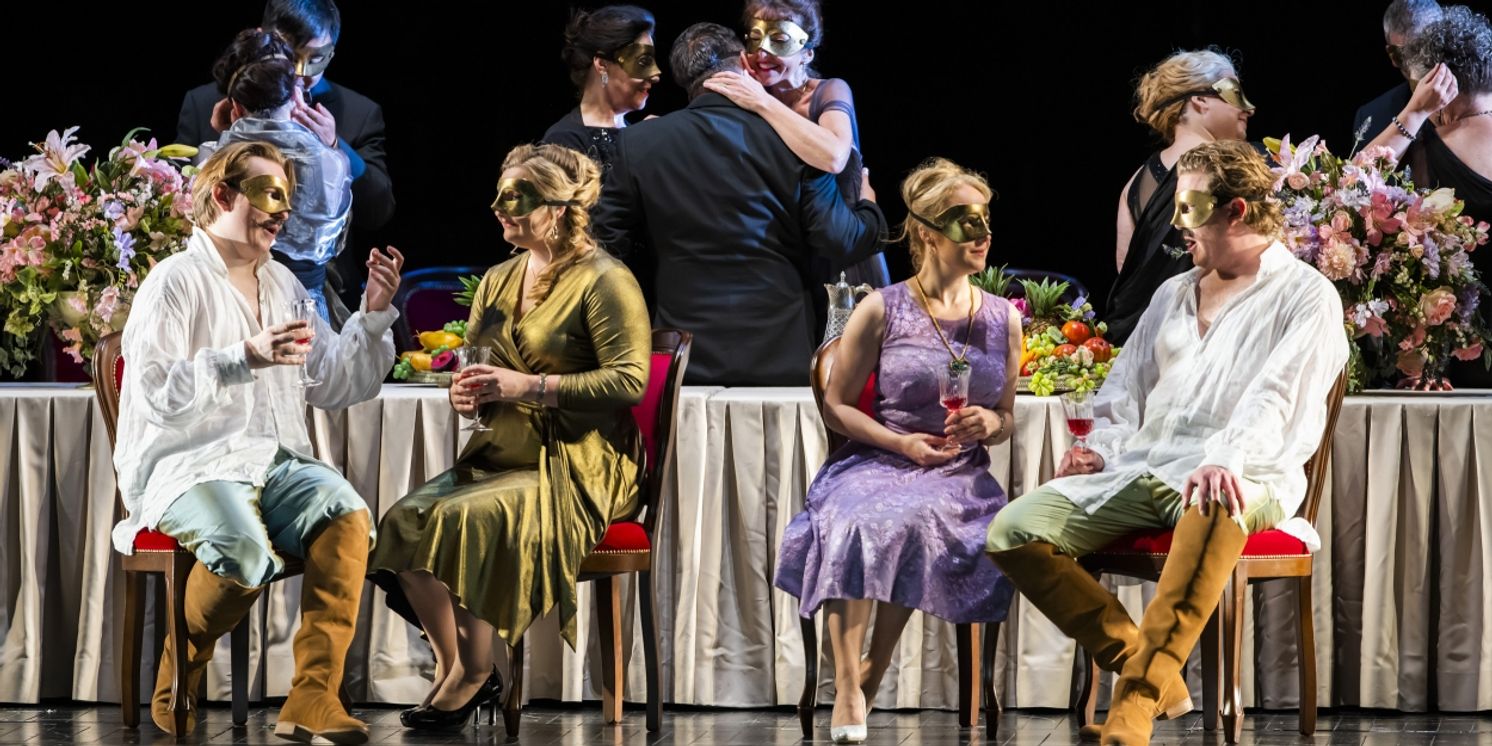Review: COSÌ FAN TUTTE at Royal Opera House
The 2016 ROH production returns, until 9 July.

![]() Mozart's Così fan tutte has always been a work that tells us about ourselves. The tale of two hapless lovers, Ferrando and Guglielmo, and their attempts to prove that their girlfriends, Dorabella and Fiordiligi, will be faithful in their absence (and to win a bet against their friend Don Alfonso, who believes the titular adage "all women act like that") is a timeless parable of attitudes towards gender, how we ought to conduct ourselves in relationships, and what aspects of ourselves we present to the world.
Mozart's Così fan tutte has always been a work that tells us about ourselves. The tale of two hapless lovers, Ferrando and Guglielmo, and their attempts to prove that their girlfriends, Dorabella and Fiordiligi, will be faithful in their absence (and to win a bet against their friend Don Alfonso, who believes the titular adage "all women act like that") is a timeless parable of attitudes towards gender, how we ought to conduct ourselves in relationships, and what aspects of ourselves we present to the world.
When the men fake their absence and disguise themselves as attractive 'Albanians', it not only provides a comic device to goad their girlfriends into infidelity, but also an exploration of what we might do if all was not as it seemed, if we had an avenue through which to express our true selves.
The eventual reversing of the couples - Dorabella falls for Guglielmo in disguise, and Fiordiligi for Ferrando - has always made audiences wonder if the women could actually see through the disguises, and the Royal Opera House's staging, first seen in 2016, makes explicit this reading of the text.
Even though this crucial conceit - that the women figure out their boyfriends' ruse at the start of the second act - could be made more explicit in the opera's direction and staging, the cast must nevertheless be praised for their ability to add pathos and humanity to roles that some would interpret as vessels only for farce.
Julie Boulianne's Dorabella is especially strong, punctuating the character's journey from passive monogamy to embracing her sexuality with well-timed yelps of nervousness or of pleasure, and portraying her pride in her sexual encounter with Guglielmo with the brash self-empowerment of a female pop star.
The male leads, portrayed by Bogdan Volkov and Gordon Bintner, embrace the physical comedy of the piece (their writhing in time with Mozart's trills after being 'poisoned' at the end of the first act is a particular highlight) while not shying away from its darker moments - the minimalistic staging during their arias in the second act refuses to romanticise their anger and threats of violence against their unfaithful girlfriends.
Although director Jan Philippe Gloger has pointed out in a promotional interview that Così represented a shift from the playful infidelity and courtly love of the Renaissance to the more marriage-oriented approach of the Romantic era, his staging seems to imply that the opera's plot is applicable to every other time period as well. Ben Baur's set cycles dizzyingly through thematic ideas and historical allusions: Adam and Eve's tree of knowledge, an Old Hollywood film set, a glitzy modern bar, among others.
While many of these sets do posit interesting ideas - the women's loss of innocence, for example, or a metatheatrical touch, reflecting the many fourth wall-breaking lines in Da Ponte's libretto - the overall impression is of the director and designers throwing ideas at the wall and seeing what sticks, rather than creating a coherent visual aesthetic.
As well as inviting negative comparisons with the highly effective and cohesive 1950s Coney Island setting of the ENO's recent production, it also sometimes feels as though the production has put too much thought into the elaborate set pieces and not enough into how the cast interact with them. Rather than arranging the six main cast members in striking formations during Mozart's exquisite harmonic renderings of their various desires, too often the cast is left to huddle awkwardly in disparate corners of the stage.
Any doubts over the production's staging choices, however, are assuaged by the ingenious set piece in the second act, a stage within a stage which deconstructs itself during Fiordiligi's emotional aria "Per pietà, ben mio, perdona" (sung expressively by Jennifer Davis), exposing cameras, spotlights, and other cinematic memorabilia.
Revealing Fiordiligi's confusion over her feelings to be some sort of facade or performance breaks down the fourth wall and enables the audience to consider their own role as viewers, and wonder to what extent Fiordiligi and the other characters are 'performing' their roles of lover and beloved; unlike its predecessors, this set piece does not feel as though it values style over substance.
Così's ambiguous ending, in which the women are hurriedly married off to their original lovers, now relieved of their disguises, is treated in a similarly metatheatrical way. Rather than taking Da Ponte's words at face value and acquiescing to the Shakespearean comedy-style resolution via marriage, in this production the new couples walk off in a deeply anticlimactic manner, shooting glances of confusion and dissatisfaction at one another. It is almost as if the characters have been forced, by the conventions of the genre, into a situation which is unsuitable, as they have spent the last act figuring out.
The ROH's Così is keen to play with the work's shortcomings, and tease apart the ways in which it reflect its audience's perceptions of monogamy, gender and identity. The various ways it does this, both through the actors' performances and the show's staging, occasionally fall short, but the production is still highly effective in demonstrating that there is more to Così fan tutte than farce.
Così fan tutte runs until 9 July.
Photo Credit: Tristram Kenton.
Reader Reviews
Videos

